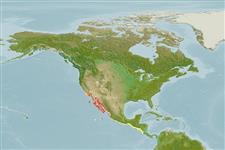Common names from other countries
Environment: milieu / climate zone / depth range / distribution range
Ecologia
marino associati a barriera corallina; distribuzione batimetrica 1 - 61 m (Ref. 2850). Subtropical; 37°N - 10°N, 123°W - 85°W
Eastern Central Pacific: Monterey in California, USA to Mexico, including the Gulf of California. Also reported in Nicaragua (Ref. 13613).
Length at first maturity / Size / Peso / Age
Maturity: Lm ?, range 9 - ? cm
Max length : 60.0 cm TL maschio/sesso non determinato; (Ref. 26550); peso massimo pubblicato: 900.00 g (Ref. 40637); Età massima riportata: 20 anni (Ref. 56049)
Usually found on sand or mud bottom near rocks and eelgrass, from the coast to a depth of 60 m. A secretive species, it feeds on small fishes and benthic crustaceans during the day (Ref. 9342). Capable of tolerating ample fluctuations of temperature (from 7.5 to 32°C) and survive extreme cold intervals (Ref. 9342). Pelagic spawners (Ref. 56049). Important game fish caught in bays and harbors (Ref. 9342). Minimum depth range based on occurrence (Ref. 79604).
Pelagic spawner (Ref. 56049). Protogyny (Ref. 32126) as proposed has been corrected by a more detailed study on several species which confirmed this species and all of the members of the genus to be gonochoristic (Ref. 103751).
Eschmeyer, W.N., E.S. Herald and H. Hammann, 1983. A field guide to Pacific coast fishes of North America. Boston (MA, USA): Houghton Mifflin Company. xii+336 p. (Ref. 2850)
IUCN Red List Status (Ref. 130435)
CITES (Ref. 128078)
Not Evaluated
Threat to humans
Harmless
Human uses
Pesca: di nessun interesse; Pesce da pesca sportiva: si
Informazioni ulteriori
BibliografiaAcquacolturaProfilo di acquacolturaVarietàGeneticaElectrophoresesEreditarietàMalattieElaborazioneMass conversion
CollaboratoriImmaginiStamps, Coins Misc.SuoniCiguateraVelocitàModalità di nuotoArea branchialeOtolithsCervelliVista
Strumenti
Special reports
Download XML
Fonti Internet
Estimates based on models
Preferred temperature (Ref.
115969): 18.1 - 26.8, mean 22.3 (based on 42 cells).
Phylogenetic diversity index (Ref.
82804): PD
50 = 0.5020 [Uniqueness, from 0.5 = low to 2.0 = high].
Bayesian length-weight: a=0.01288 (0.00809 - 0.02051), b=3.00 (2.88 - 3.12), in cm Total Length, based on LWR estimates for this species & Genus-body shape (Ref.
93245).
Trophic level (Ref.
69278): 4.1 ±0.56 se; based on food items.
Resilienza (Ref.
120179): Medio, tempo minimo di raddoppiamento della popolazione 1.4 - 4.4 anni (tm=1.5; tmax=20; K=0.296).
Fishing Vulnerability (Ref.
59153): Moderate vulnerability (37 of 100).
